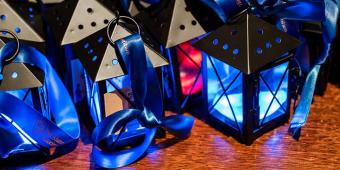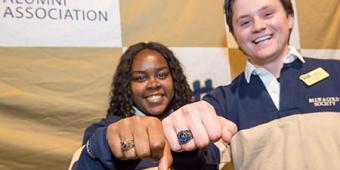Since 1787, the University of Pittsburgh has never stopped pushing the edge of what’s possible. We were forged in the spirit of progress and the thrill of the unknown. Over 200 years later, we are still driven to create new paths and build better futures. As one of the nation's oldest educational institutions, our rich history and traditions contribute to our culture of continuous growth, innovation, and excellence.
“Hail to Pitt,” featuring that official University yell, was written by Pitt students Lester Milton Taylor and George Morrill Kirk in 1910 and debuted in a production of the student theater organization that spring. The tune was an immediate hit among students and, with a little help from cheerleader Kirk, soon became an official Pitt fight song.
Today, “Hail to Pitt” is a constant presence at University events, and H2P is a familiar rallying cry for the Pitt family.

Lantern Night is one of the oldest Pitt traditions in which Pitt alumnae pass on the "Light of Learning" to Pitt's newest students in a ceremony at Heinz Memorial Chapel before the start of the fall semester.
Each of the participating students receives a lantern that is lit by one of the Pitt alumnae, symbolizing the “light of learning”. In celebration of its 100th anniversary in 2020, Pitt made the decision to open the event to first-year students of all gender identities in festivities (originally a female-only event), a new choice inspired by efforts to create a more inclusive environment at Pitt.
During fall term, Pitt students gather for week-long festivities to celebrate Homecoming. On the Friday night before the big game, the Pitt Program Council puts on an unforgettable laser and fireworks show followed by a Monte Carlo night at the William Pitt Union. On Saturday at Heinz Field, the Pitt community gathers for the annual homecoming football game and celebration.
Heinz Chapel was constructed and donated to the University by the Pittsburgh entrepreneur and condiment man, John Henry Heinz. The steps in front of the chapel are said to be a good luck charm for young couples.
A point of convergence for Pitt students, faculty, and staff since it was erected in fall 2001, this panther statue greets those who enter the south side of the University’s William Pitt Union. The bronze statue was cast in Parma, Italy, and serves as both a tribute to Pitt and a reminder of the University’s fierce Panther Pride. A time capsule, to be opened in 2051, lies buried beneath the statue.
If you get close, you will notice the nose of the panther statue is a different texture. This is due to years of students rubbing its nose for good luck!
The Oakland Zoo, the student section of Pitt’s basketball teams, established itself as one of the best in college basketball starting in the early 2000s, coinciding with the rise of Pitt men’s basketball and the construction of the Petersen Events Center.
The Zoo helps to create raucous environments, striking fear into opposing teams and setting the tone for one of the best home courts in the country, with one of the best home records to match!
Sweet Caroline has been dubbed the second alma mater of the University. During every Pitt Football game, the crowd link arms, sings the Neil Diamond classic, and shouts “Let’s Go Pitt.”
Located on the first and third floors of the Cathedral of Learning, the Nationality Rooms consist of 30 classrooms that were designed to represent the ethnic groups that have settled in Pittsburgh. Nearly 30,000 visitors tour the Nationality Rooms each year, with a high volume in December when each of the rooms are decorated for the holidays.
One of Pitt's most iconic traditions, the Victory Lights have bathed the top of the Cathedral in gold following football wins as well as championships won by other Panthers teams.
Updated in 2018, through the generosity of Chris Bickell, a 1997 graduate of the University and passionate supporter of Pitt Athletics, the Victory Lights now features an additional blue beam that dramatically shoots straight up into the sky. The result is a breathtaking combination of Blue and Gold atop Pitt's most recognizable campus structure and is visible from numerous points in the city.

Every year, the incoming first-year class attempts to break a world record at New Student Convocation. In past years, students have broken the World Record for “The Largest Torch Lit Logo (PITT in block letters),” and “The Largest Cupid Shuffle Dance.”
Pitt’s beloved mascot is generally referred to as the Pitt Panther, while the costumed panther mascot is named "Roc." Up to 20 physical representations of panthers can be found in and around the university's campus and athletic facilities.
- The Panther was adopted as the Pitt mascot at a meeting of students and alumni in the fall of 1909 and was chosen for the following reasons:
- The Panther was a formidable creature and was once indigenous to the Pittsburgh region.
- It had ancient, heraldic standing as a noble animal.
- The happy accident of alliteration.
- The close approximation of its hue to the old gold of the University's colors (old gold and blue).
- The fact that, at the time, no other college or university used the panther as a mascot or symbol.
People crossing the first-floor lobby of Pitt’s Wesley W. Posvar Hall may not realize that an inconspicuous glass block in the floor holds a significant piece of American baseball memorabilia. Beneath the glass block lies the home plate of Pittsburgh’s Forbes Field. The plate is near the spot where the likes of Honus Wagner, Roberto Clemente, Willie Mays, and Hank Aaron once batted, and where Babe Ruth launched the final three home runs of his career.
Similar to rubbing the Panther’s Nose, students can be found jumping on top of home plate for good luck!
Situated between the Cathedral of Learning and Heinz Memorial Chapel, are two stone walkways. The first walkway preserves the names of Pitt’s Omicron Delta Kappa (ODK) Senior of the Year award winners. ODK is a national leadership honor society that recognizes achievements in areas such as scholarship, athletics, community service, social/religious activities, journalism, and the arts. The walkway is the only one of its kind in the country.
Parallel to the ODK Walkway is the Varsity Walkway, which commemorates former Pitt athletes who have promoted the University through their athletic or academic achievements.

Each spring, the Pitt Class Ring Ceremony takes place to symbolically commemorate the unique and lifelong connection alumni have to Pitt. As part of the ceremony, each ring spends the night at the pinnacle of the University, atop the Cathedral of Learning in the Babcock Room. The rings are placed there as a symbol of the heights each of its wearers will reach upon graduating from Pitt.
